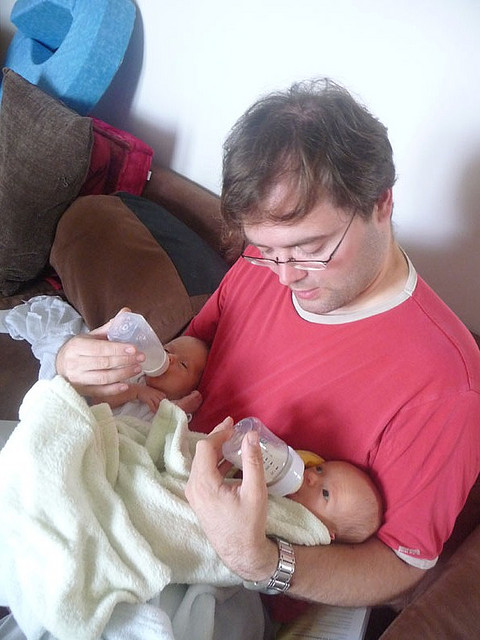Scheduling with Multiple Babies

One of the first big challenges to tackle when you bring home multiple babies is what you’re going to do with them. When are you going to feed them? How do you know when they’re supposed to sleep and for how long? Do they both do everything at the same time and what if they don’t?
Ideally, babies should be on a three hour schedule; sleep for an hour and a half, eat for thirty minutes or so, play for forty-five minutes (including tummy time and increasing the time to allow them to soothe themselves). I know all of the books say to keep them on a schedule so they can get used to routines, know what to expect, and start preparing themselves for the next step in the schedule. I think that’s a great idea.
Babies are likely going to put themselves on a regular schedule anyway. Don’t you typically get hungry at the same times and get tired at the same times? So will your little ones. It’s advisable to get them started right away, but in order to be successful, you’ll have to really pay attention to their cycles; when they want to sleep, when they usually get hungry, etc.
You obviously don’t want the babies to run your life, but before you discover these specific cycles, it might feel like it. I know it sounds like a great idea to keep both (all) babies on the same schedules when you have multiples; feed them at the same times, put them down at the same time to sleep. This gives mom a break, allows her to rest and get chores done while babies are sleeping. Sounds great right?
Unfortunately keeping multiple babies on the exact same three hour routine, at the same exact times, is not reality. It's a wonderful thought to believe that you can get two or more individuals with different personalities, needs, and desires to want to eat at the same time, sleep at same time, and want to always do the same things as their siblings at same time. I wish it were so, but at some point every mom must realize that they have different children.

Setting a Schedule
I strongly suggest getting started on a schedule from the very beginning and getting into a regular routine with your babies. (It's the only way you'll stay sane in the long run.) Obviously they wake up on their own and let you know when they’re done sleeping, feed them. They’ll usually be hungry as soon as they wake up and will let you know it.
Follow your doctor’s advice on how much to feed them (or for how long) and they’ll let you know when they’re done. Let them play, have fun, enjoy your children, and they’ll give you the tired signs (yawning, rubbing eyes, getting fussy) when they are ready for a nap. Easy. You don’t want to wait to see the signs to do anything, but these signs will help to tell you what they need and when.
But when you see that Jack is crying 45 minutes into "nap time" everyday only to be forced awake unhappily 45 minutes later, and Jill is going to sleep easily right at "nap time" everyday only to wake up 45 minutes early screaming for food every time, you'll see the folly. Not that there’s anything wrong with scheduling, but you have different children.
Keeping all babies on the same schedule is hard work, for you. Not that it’s not possible to feed multiple babies at the same time, but at some point you’ll have to burp separately and diaper separately. Doing this is simply creating more work and less down time for yourself. Consider staggering their schedules by 30 minutes or so. This will give you time to take care of one while the other(s) is busy, and will give you plenty of time to have one-on-one individual time with each child.
If you have more than two babies, you may need some help, and there’s nothing wrong with that. But this allows each baby to sleep when he or she is ready, eat when he or she is ready and still have time to play with his or her sibling(s). And one great thing about multiples is that they are able to amuse and entertain each other.
Quick Quiz
view quiz statisticsUnderstanding Their Differences
From the very beginning with multiples, you’ll be able to see their different personalities. Just like two babies from different parents, your two babies will want to be held differently, talked to differently, swaddled differently, etc. Just because they both look kind of alike and they are both your babies, doesn’t mean that they aren’t their own individuals.
Especially with multiples, they become “the babies.” Parents try to treat them the same, feed them the same, and dress them the same, as if they truly only have one baby. Tracy Hogg, author of Secrets of the Baby Whisperer, states that “parents of twins tend to look between, not at, their babies.” However, they are two individual human beings, needing individual attention and treatment of their needs.
You wouldn’t expect everyone in your household to dress the same, like the same foods, read the same books, or like the same TV shows. You are all different people with different predispositions, and so are your babies. They deserve to be treated as individuals, and that means looking them in the eye and recognizing their differences.
Listening to Your Children
Babies cannot communicate with words just yet, although I bet they wish they could. So getting their needs and desires across to their parents is complicated. Crying and fussing is probably going to be the majority of their communication, but if you look closely, you can also start seeing more subtle communicating going on.
Just like a yawn, rubbing eyes, and an inability to keep the eyes open are all signs of being tired, your babies are trying to tell you with their body language what they need from you. A curling tongue, an arched back, and a neck craned with the mouth open usually mean hunger or a need to suck. Shaking arms, legs pulled up to chest and/or grimacing usually means gas or a bowel movement. The body movements make sense. You just have to be paying attention.
Many parents just jump into picking up their children and rocking them when they seem uncomfortable, but sometimes the best action is no action. Step back and take the time to see what your child or children are saying to you to determine what they need. The more practice you get at this, the better you will get at anticipating their needs.

Anticipating Their Needs
Start writing down what they need and when. You might notice that one sleeps a little longer during naps than the other, or that one doesn’t eat quite as much as his or her sibling(s). Does one have a lot of gas normally? Does one respond differently to one kind of formula than another?
These are important patterns that you need to be aware of in your children. However, most parents treat multiples so alike that they don’t take the time to notice the differences. This may mean a great deal of crying or fussing (from both mom and baby) while mom is simply responding without truly hearing what baby is saying.
By really paying attention, listening to your children, and understanding their different personalities, needs and schedules, you will begin anticipating each of their needs and be able to respond before it becomes a National emergency (you know what I mean, lol).
“She always wants her pacifier right before bed.” “He likes to be held this way.” “If you burp her halfway through her feeding, she’ll calm down and finish eating.”
Aren’t these the kinds of things you’d like to know about your babies?
Forcing a Schedule
If your babies know exactly what they need and when and you’re not paying attention, you're doing yourself, and all babies involved, a serious disservice by forcing them into a schedule that doesn’t work for them. This causes tantrums and tons of stress that are unnecessary. This would be like someone forcing you awake at 3:00am in the morning to eat a big meal and play when you’re sleepy. I would sure be grouchy.
This is about finding peace in your household, and having a happy family. No tantrums, no crying, and truly understanding the little ones in the house, make for an extremely happy mommy and daddy. When you can anticipate their individual needs, you can avert the crying and tantrums almost altogether. Wouldn’t that be ideal?
The only way to know what your children truly need is to watch them and listen. They may not tell you with words, but they’ll tell you.
Quick Poll
How do you feel about keeping multiples on the same schedule?
© 2013 Victoria Van Ness








